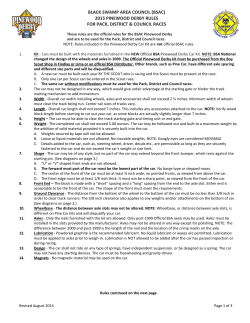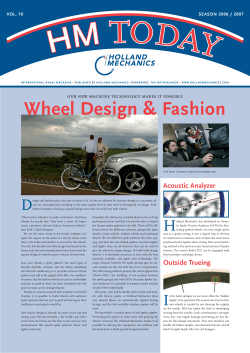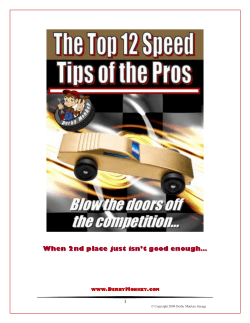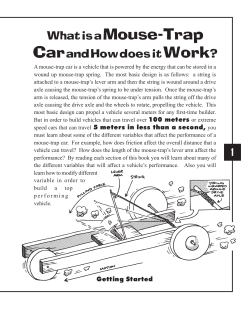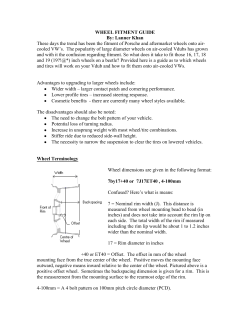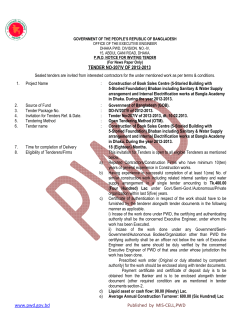
Top Ten Tune-Up Tips & Tricks For Building Pinewood Derby Cars
Top Ten Tune-Up Tips & Tricks For Building Pinewood Derby® Cars Introduction Since its founding in 1953, Pinewood Derby (PWD) races have hosted literally millions of hand-crafted pine cars, and continue to do so each year. The PWD is the most time-honored and anticipated event for Cub Scouts. In fact, its popularity for Cub Scouting sparked similar pine car racing events by other organizations worldwide - not just for children, but for adults who enjoy the healthy competition and thrill of designing, constructing and racing gravity powered cars. In light of this, there are countless resources available that intricately detail the physics and other precisely calculable factors involved in PWD racing. If you enjoy this exacting intensity, then go for it – you will be pleasantly surprised at the results of applying your studies. Here’s a link to get you started: www.pinewoodprofessor.com. If, however, you aim to give your child a winning chance without a huge time or financial investment, while promoting the “Do Your Best” motto, then consider these tips and tricks. This guide synthesizes experience and information from different sources, then cuts to the chase. It is neither comprehensive nor limited, so by all means independently research any aspect for more details (try Google or YouTube, for example). But, hopefully, this will make your child’s car better while simplifying the building process. (Any initial expense will pay for itself considering that your child could build up to five PWD cars as a scout.) And, always follow the rules (length, width, height, weight, etc.) for your race – they control. Of course, your child should do as much of the work as possible and should be able to do almost everything below - and more with age and experience. That’s your call. Use the opportunity to teach tool and workshop safety. Please heed the warnings and follow the directions on the tools and products you use. As far as PWD physics go, remember this basic lesson: gravity is your friend, friction is your enemy. 1. Be Creative The PWD is by all accounts a speed race. But, when designing your car, don’t worry about the shape/style of the car in relation to speed. For Cub Scout or similar child-level PWD racing, aerodynamics plays little, if any, role in speed. So, encourage your child to be creative and build whatever shape car or other object they can think of; let them own the design. And check the award categories for your event – many include originality, best design, best paintjob, or some other nonspeed theme to win. For design ideas, try a simple Google Images search like “pinewood derby cars” – the creativity will astound you! 2. Heavy In The Rear Weight placement is extremely important to a PWD car (“gravity is your friend”). A car with the maximum allowable weight could still stop short of the finish line simply because the weight is in the wrong place. Fast forwarding through the dynamics, put the weight in the rear (above or behind the back wheels), not more than about 3/4" forward of the rear axle slot. If mounting the triangular, flat waffle weight to the underside of the car, put the wider part towards the rear. Page 1 of 5 Copyright © 2012 Derby Gurus – All Rights Reserved 3. Weigh As You Go For Cub Scout PWD races (and many others), the weight of the car cannot exceed 5 ounces - and you want it to be 5 ounces. Don’t suffer rejection at the final inspection because the car is 5.1 or more ounces. Then, to qualify, you have to lighten it on the spot, if possible. So, don’t guess as you go; weigh as you go. (But not with postal scales – they are not calibrated the same and certainly not for PWD cars.) Use a food scale if you have one; if you don’t, invest in a scale. Manual (holding 25 US quarters) and digital versions are available on eBay for under $20. Consider sharing the expense with another parent. It’s well worth it. When you first open the kit, weigh the block, the axles and wheels together to check the total raw weight. Get an idea of how much weight you can add to reach 5 ounces. The block weight will decrease when you cut/shape it, but the overall car weight will increase when you add weights, wheels, axles, accessories, even paint. After you cut the basic shape, weigh it all again. After you drill the holes for weight, weigh it all again. After you install the weight, weigh it all again. After you paint it, weight it all again. After you install the wheels, weight it all again. See the pattern here? When it doubt, shoot for 4.8 – 4.9 ounces; then you can add a little exterior weight (glue a US quarter = .2 oz) underneath at the end. By the same token, if you’re an ounce over, you can drill holes in the bottom – preferably the front - to remove wood mass. 4. While It’s Still A Block Before cutting into the pine block, take advantage of its rectangular shape to perform certain tasks. First, with the block on its side, create a round groove in each axle slot to make installing the axles later very easy. If you have a drill press, lock a section of 3/8” dowel (or pencil) into the chuck, then with the press turned off press the axle halfway into a slot by slowly lowering the chuck. If no drill press, clamp the block down and use the 3/8” dowel to push them in slowly (tap the dowel lightly with a hammer handle, if necessary). Take your time to go in straight (if needed, use a penny to hold the axle against the top of the slot as you drive it in). Do one side at a time and remove the axle carefully without Press axle straight in halfway marring or scratching it. Second, sketch out the shape of the car on the top, ends and sides so you have a cutting guide. Start with pencil, then finalize with a fine permanent marker and erase the pencil lines. (Printable patterns are available online.) Third, drill holes for the weights. The easiest to install are the round, notched lead weights (but tungsten is better). Drill a test hole in a scrap of wood and check that the weight fits smoothly (usually 7/16” to 1/2” diameter). With the correct sized bit, drill the holes in the locations as explained in #2 above, keeping in mind your Drill press for the side design and where you will be removing wood later to form the shape of the car. (In other words, if you intend to round off the corner, don’t put the weight all the way to the corner; put it further in, or in a different location.) Also, if drilling from the side or Hand held drill for the back end Page 2 of 5 Copyright © 2012 Derby Gurus – All Rights Reserved bottom, try stopping just short of going through the other side to avoiding having to wood fill both ends. For best results, use a drill press that is set to stop short; if no drill press, put a piece of tape around the drill bit so you know when to stop. Then with a hacksaw cut your weight down to a length a bit shorter than the depth of the hole. Put a little wood glue into the hole, insert the weight and let dry upright. Once dry, fill the hole with wood filler, let dry and sand smooth. 5. Cutting & Shaping The most time-consuming part of building a PWD car is the cutting and shaping. If you are relatively handy and have a decent selection of tools, you will know how to reduce the block to your design. Generally, for cutting and shaping PWD cars, it’s easier and safer to use stationary tools and move the wood rather than trying to move the tool against the small block. So, a band saw and overturned belt sander (or drum sander in a drill press) are invaluable. If you don’t own them, find someone who does. A handheld electric jig saw can also be useful, but clamp down the block when cutting. (While a manual coping saw is a commonly suggested tool, you will probably toss it across the room in frustration after five minutes.) After the rough cutting and shaping, orbital/vibrating sanders can slowly remove more material and smooth out the final shape. If you have a Dremel, consider adding some finer details. Then finish off all surfaces with 220 grit sandpaper by hand. 6. Painting & Finishing Once the car is shaped, smooth and dusted off, it’s time to paint. To provide a way to hold and hang the car while painting and drying, install a 1 1/2” long round end screw hook on an angle in the center of one of the axle slots underneath the car. Next, coat all surfaces evenly with Kilz or similar waterbased spray or brush-on primer. Once the primer is dry, inspect the surfaces and fill any major imperfections with wood filler, sand and re-prime. Hang and hold car with a screw hook For the top coat, use acrylic hobby/arts and crafts paints. They are inexpensive, available in many colors, clean up with water, dry quickly, apply effortlessly by brush and can easily be repainted if a mistake is made. You can even mix and apply multiple colors for detail with ease. Once the paint is dry and you are satisfied with the result, seal the entire car with 2 to 3 thin coats of a fast-drying clear spray. This will provide a nice clean, protective finish. 7. Polish The Axles & Wheels As important as weight placement is having smooth axles and wheels (“friction is your enemy”). They MUST be polished. There are four key friction points on a PWD car that need to be minimized as much as possible: (a) where the axle Axle polishing kit with pumice Wheel mandrel shaft rubs against the inside of the wheel bore; (b) where the inner wheel hub rubs against the side of the car; (c) where the underside of the axle head rubs against the outer wheel hub; and (d) where the wheels touch the race track. These need to be smooth. So, a wheel mandrel and an axle polishing compound are an absolute must (available at www.maximum-velocity.com). Page 3 of 5 Copyright © 2012 Derby Gurus – All Rights Reserved Put each axle in a drill press or secured handheld drill to smooth them out while they spin. Starting with a small fine file, remove those tiny parallel crimp marks toward the top of the axle and the burrs on the underside of the head. Next, smooth those surfaces with a strip of wet 600 or 800 “wet/dry” sandpaper or Emory cloth. Then apply the polishing compound as per its File crimps and burrs smooth directions. Polish until you can see your reflection in the top half of the axle! Finish off the shaft by spinning on Smooth with wet/dry paper some dry lubrication (see #9 below) with a soft cotton pad. As for the wheels, use the mandrel to spin each one in the drill press (or drill) slowly and use the wet sandpaper or fine steel wool to smooth the outside surface, if necessary (newer version PWD wheels are remarkably smooth already). Make sure the paper is wet and apply very light pressure so you don’t melt the wheel. Touch it only a second at a time. You just want to smooth off any imperfections in the plastic surface, not change its shape. When out of the mandrel, give the inner wheel hub a few light passes on the wet sandpaper. 8. Before and after polishing Wheel Alignment If you followed #4 above, then your axles will slide in easily and align themselves snuggly with the top of the axle slot. But, the inner wheel hub needs to be close to, but not touching, the side of the car. So, create a spacer by tearing off the flap of the PWD kit box and cutting a 1/2” long narrow V groove. Slip the axle through the wheel, insert the axle part-way into the slot and slip the spacer groove all the way onto the axle and hold it against the car body. Using that dowel from #4 Push wheel against spacer Simple spacer using box end above, slowly push the axle in by hand until the inner wheel hub touches the spacer; then remove the spacer. Repeat for the other wheels and they will all end up spaced evenly from the car. When doing the other side, avoid putting pressure on the wheels you just spaced by blocking up the car body so the wheels don’t touch the work surface. Protect the finished wheels Page 4 of 5 Next, place the car on a flat surface and make sure all the wheels are touching it. If not, carefully use a small screwdriver to gently push one end of the axle (the point end vs. the wheel end) deeper into the slot, depending on whether you need to lower or raise a wheel. Once they are all aligned to the surface, give the car a gentle push just to make sure it travels (relatively) straight – if you followed the above steps, it should. If not, visually check the spacing and surface alignment again. Copyright © 2012 Derby Gurus – All Rights Reserved Once you are satisfied, lay the car upside down on a towel so the bottom is relatively level. Carefully place a few small drops of a super glue gel or 5-minute epoxy into each axle slot to secure the axle in place. Do not put any glue near the wheel or the end of the slot and do not let any glue run towards the wheel. Leave the car in this position while the glue dries. 9. Lubrication, Lubrication, Lubrication Glue ONLY the axle Defeat your friction enemy with a good dry lubricant like graphite/molybdenum mix or Derby Dust. There’s no such thing as over-lubricating – pack as much as you can around the axles inside the wheel hubs, gently tap and spin the wheels to make the lubrication settle, and pack in some more (be mindful that it can be a little messy). Then, pack in even more while on line to check-in/weigh-in the car. That’s the last time you will get to handle the car until after the race. And once the car is all ready, avoid the temptation of messing with it, as this can throw off alignment, shake out the lubrication or otherwise cause damage. After all, no matter how solid it looks, a PWD is still only a block of pine with plastic wheels held on by four nails. So, keep it safe, secure and off its wheels in a shoe box, plastic food container or the like, ready for check-in and racing. 10. Have Fun The PWD is a constructive activity to promote craftsmanship and good sportsmanship through competition. But, the excitement of the event mixed with the energy of children age 6 through 10 invariably creates a highly charged atmosphere in which it is easy to lose site of the moral. As with any competition, winning is not as important as the hard work and lessons learned along the way. It should be a rewarding experience for both child and adult, regardless of skill level or results. Sometimes the difference between winning and losing can be a millisecond; so keep expectations low, but pride and excitement high. Emphasize respect for others and the building accomplishment itself; a child who was deeply involved in the design and construction of their PWD car will appreciate it more even if it loses. Make sure to have fun – otherwise, there’s no point in doing this. When the race is over, preserve your work and fond memories by proudly displaying the cars on a Grand Stand – The Only Adjustable PWD Multi-Car Display System. Good luck and thank you for visiting Derby Gurus. www.derbygurus.com Page 5 of 5 Copyright © 2012 Derby Gurus – All Rights Reserved
© Copyright 2025
